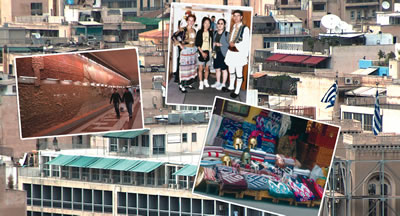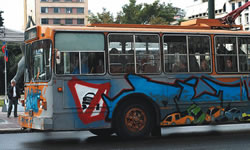WELCOME
Snapshots of Athens
by Nikos Melas
At the crossroads of East and West, of antiquity and modern times, you will find Athens, Europe's most unusual capital; the only one uninterruptedly inhabited for the last 5.000 years.
 It is not that easy to understand such a city and its population. There are over 3,5 million people living there, most of them first or second generation Athenians, due to the population explosion that occurred in Athens in the 1950s and 1960s and then again in the 90s with the influx of immigrants. These people have brought with them their different backgrounds from every corner of Greece, making Athens an incredible mishmash of trends, ideas, subcultures, tastes. But despite this influx, all these people consider themselves Athenians, love their city, complain about it, enjoy it and miss it when away from it. Because Athens is unique. It is not that easy to understand such a city and its population. There are over 3,5 million people living there, most of them first or second generation Athenians, due to the population explosion that occurred in Athens in the 1950s and 1960s and then again in the 90s with the influx of immigrants. These people have brought with them their different backgrounds from every corner of Greece, making Athens an incredible mishmash of trends, ideas, subcultures, tastes. But despite this influx, all these people consider themselves Athenians, love their city, complain about it, enjoy it and miss it when away from it. Because Athens is unique.
Stroll around downtown and you will sense it immediately. Athenians drink coffee or eat lunch next to ancient pillars and temples. They wander among the neo-classical houses of Plaka and attend concerts or ballets in huge ancient theatres. At the same time, they dine in ultra chic restaurants, dance in bouzouki halls, drink ouzo by the sea, and swim at the beaches of the coastal suburbs. Despite the chaotic traffic during working hours, the city has an intense Mediterranean feel, a result of its seaside location and the joie de vivre of its inhabitants. Sidestreet cafes and open air restaurants abound, the whole Athenian population seems to take turns on their chairs all day long. After dark comes a unique transformation. The activity downtown drops dramatically; the smaller streets of the centre look semi-deserted. Other neighbourhoods start lighting up. Cinemas and theatres, gourmet restaurants, trendy bars and raucous clubs offer innumerable possibilities. Nightlife starts strictly after 11 pm (gay bars around midnight) and traffic jams form in the early morning hours, when people finally decide to return home from their nightlong entertainment.

Athens is a large city, too. Sprawling from the surrounding mountains to the sea, it has dozens of neighbourhoods. You, however, being a casual tourist are most likely to stay downtown, where most hotels are found and where most transportation originates or ends. Although many areas of the city are self-sufficient with independent commercial centres and amusement possibilities, Athens is quite a centralised city.
 The Center, or Kendro, as Greeks call it, is an area stretching roughly between the Acropolis, the Omonia and the Sindagma Squares. It is quite manageable on foot, but it is also very well served by the Metro (subway, which Greeks pronounce a la francaise). In this area you will find Plaka, the oldest part of the town and the only one which has kept its architectural identity intact. It is an island of tranquillity and perfect for a stroll, with beautiful old houses, flowerpots and gardens, canary birds in their cages and sleepy cats. The Center, or Kendro, as Greeks call it, is an area stretching roughly between the Acropolis, the Omonia and the Sindagma Squares. It is quite manageable on foot, but it is also very well served by the Metro (subway, which Greeks pronounce a la francaise). In this area you will find Plaka, the oldest part of the town and the only one which has kept its architectural identity intact. It is an island of tranquillity and perfect for a stroll, with beautiful old houses, flowerpots and gardens, canary birds in their cages and sleepy cats.
Here of course are to be found the Acropolis complex with the magnificent Parthenon as well as the Agora (Forum), the Attalus arcade, the Mitropolis Cathedral and the Parliament Building.
From Omonia Square to Plaka via Athinas Street youíll come as close as it gets to the colourful Middle Eastern bazaars. If the fishy smell is beyond your tolerance limit, you can drop the historical fish market, but the spice shops along the nearby Evripidou Street are a unique experience and not to be missed.
When shopping, especially for clothes and shoes, no area in Athens quite beats Ermou Street. Now a pedestrian zone itís also a pleasant stroll from Sindagma Square to the Roman Forum. If you fancy a flea market, then the Monastiraki Square area offers the best one in Athens.
Within the confines of the centre youíll find the Archeological, the Benaki and the Byzantine Museums, the three best in Athens and not to be missed at any cost.
For coffee with a view (i.e. handsome men and boys) try for a popular Greek pastime, sitting outside in one of the Kolonaki Square cafes. Not the cheapest in Europe by far, but here you pay for the location and the spectacle and not just for the java. Before making up your mind where to sit, stroll up and down and check the crowds first. Try also the smaller but equally interesting, nearby Milioni Street pedestrian zone for young and trendy crowds.
 The closest areas to the Centre for nightlife are Plaka and Psiri, both within walking distance of the Sindagma and Monastiraki Metro stations respectively. Although Plaka is more of a tourist trap, you can still find a few restaurants catering predominantly to Greeks. Psyri, a recently refurbished neighbourhood, teems with nightlife. Restaurants, wine bars, cafes, music clubs and theatres attract people by the thousand every night. The closest areas to the Centre for nightlife are Plaka and Psiri, both within walking distance of the Sindagma and Monastiraki Metro stations respectively. Although Plaka is more of a tourist trap, you can still find a few restaurants catering predominantly to Greeks. Psyri, a recently refurbished neighbourhood, teems with nightlife. Restaurants, wine bars, cafes, music clubs and theatres attract people by the thousand every night.
Last but not least, the gay scene has been getting more and more exciting during the last few years. Convenient areas for late night fun are the upper part of Singrou Avenue, the Gazi area and the Iera Odos crossroads with Constantinoupoleos Street.
We hope that this short orientation guide will help you get the most of Athens, no matter how long your stay. We are certain that from now on you will shake your head at travellers who skip the capital for the sake of the islands!
|


